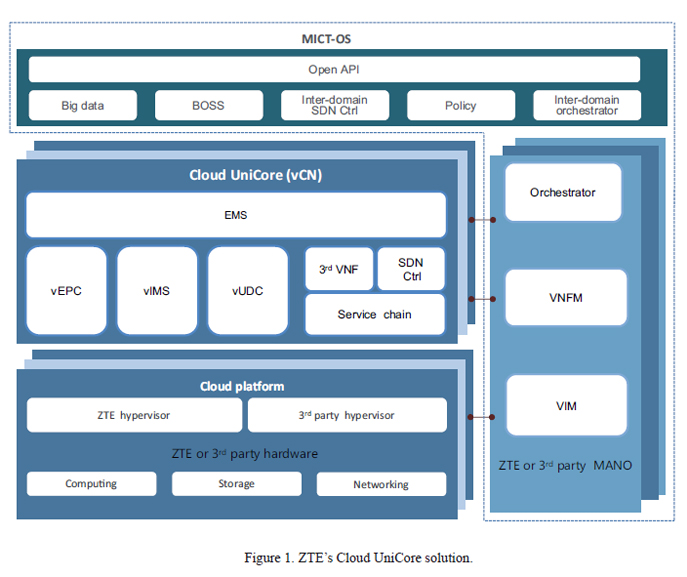NFV Makes Networks Lighter
In the mobile internet era, traditional telecom operators are facing severe challenges from internet companies. With its competitive advantages arising from innovative technologies and ultra-low cost, over-the-top (OTT) business has been eating into the profits of operators' traditional business, thereby leading to a slowdown in voice and SMS revenue growth. Traditional telecom operators urgently need to reduce their Capex and Opex to make networks lighter.
To help operators with business transformation, ZTE has launched an integrated Cloud UniCore solution. Through cloud-based technologies such as network function virtualization (NFV) and software-defined network (SDN), ZTE can build highly flexible, open, cost-efficient, innovative core networks for operators.

By using the unique TCSA architecture, ZTE's Cloud UniCore solution is a new-generation native cloud application that has both IT and CT advantages. This solution supports 2G, 3G, and 4G network access with a low-coupling and stateless hierarchical architecture. In this solution, public modules are independent of service logic, thereby acting as universal components. The service processing control plane is separated from the user plane for flexible deployment. Core networks based on components and micro-services enter the native cloud stage and can meet the operational needs in the 4G big-data convergence network age and the application scenarios of internet of everything (IoT) in the future 5G era.
Traditional network devices of an operator are running on dozens of dedicated or private platforms that cannot be operated and maintained in a unified manner. This causes extremely high manpower and material costs. ZTE's Cloud UniCore solution can help operators make their networks lighter. The solution unifies various equipment platforms and decouples software from hardware so that operators can purchase hardware separately. All the products adopt unified software architecture and can greatly simplify network operation and maintenance.
Previously, an operator needed several months of time to market (TTM) for a new service. However, NFV can significantly reduce the time for new service deployment through an automatic service process. NFV shortens the hardware and software purchasing periods by six weeks, the software deployment time by one week, and the network commissioning time by 79%. Moreover, NFV can achieve automatic network elasticity. It took several weeks to expand equipment capacity in a traditional way, while NFV can complete the expansion in several minutes. This greatly enhances network agility so that operators can take the challenges of network development in stride.
In the field of cloud-based networks, ZTE has always insisted innovation in R&D and has actively driven the industry applications. Throughout the year of 2016, ZTE carried out extensive cooperation with global operators and achieved remarkable results.
In November 2016, China Telecom announced a joint effort with ZTE in the field trial of VoLTE in Sichuan and Guangdong using virtualization and centralized large-region mode. On December 6, less than two weeks after the announcement, Sichuan Telecom successfully made the first voice over LTE (VoLTE) call in China. This is the first field VoLTE call of China Telecom, and ZTE is highly recognized by Sichuan Telecom as its equipment and service provider for this project. On December 16, 2016, the first voice call between the network devices from different manufacturers was successfully made in the other VoLTE project constructed by ZTE for China Telecom in Guangdong. On December 17, ZTE took the lead in making an inter-provincial (Guangzhou-Hunan) VoLTE video call. On December 24, ZTE again successfully made the first call between different regions. So far, ZTE has made four first calls in China Telecom's VoLTE projects.
ZTE's NFV core network also helps overseas operators with cloud-based network transformation. The vIMS network built by ZTE for Telefonica in seven Latin American countries provides HD voice, HD video, and FMC services, creating a brand-new service experience for users. ZTE also uses intelligent, automatic operation and maintenance and implements centralized deployment of the control planes in multiple countries. This helps Telefonica reduce operational workload by 70%.
The boom of cloud technologies, cloud storage and big data gives rise to a thriving digital information ecosystem based on cloud computing, cloud storage, and ubiquitous communication. ZTE's future-proof Cloud UniCore network architecture leverages SDN and NFV architectural framework and introduces the concepts of cloud, big data, and openness to build a software-defined, hierarchically and centrally controlled, elastic network. This provides operators as well as government and enterprise customers with new ideas of network construction and brings them new business value.